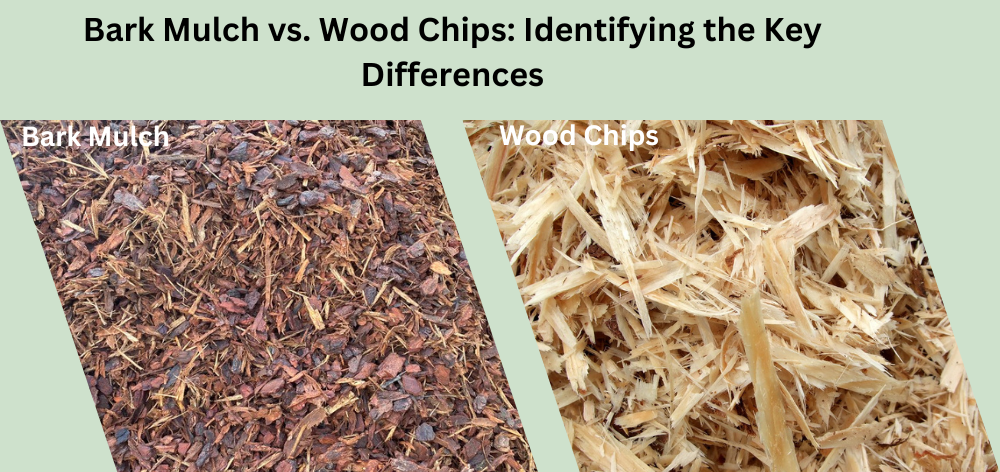
Bark Mulch vs. Wood Chips: Identifying the Key Differences
Bark mulch and wood chips, both popular landscaping choices, differ in appearance and composition. Bark mulch offers natural colors and textures, while wood chips, derived from various wood types, provide versatility. Consider your aesthetic preferences and functional needs to choose the perfect option for your garden.
However, you should be aware of some drawbacks to using wood chips before making a decision.
There are a few key differences between bark mulch and wood chips. For one, bark mulch is typically made from tree bark, while wood chips can be made from various materials, including tree bark, sawdust, and even recycled newspapers. Bark mulch is also usually finer and more uniform in texture than wood chips.
Bark mulch has a number of benefits for your garden. It helps to suppress weeds, retains moisture in the soil, and keeps your plants’ roots cool in summer weather. Bark mulch also breaks down slowly over time, adding valuable nutrients to the soil as it does so.
Wood chips have some different benefits than bark mulch. They tend to break down faster than bark mulch, making them ideal for use as a temporary ground cover or weed blocker. Wood chips also add bulk to the soil, which can help improve drainage and aeration. And like bark mulch, wood chips will eventually break down and add nutrients to the soil.
Bark Mulch Color and Texture
Bark mulch offers a spectrum of natural colors, from rich browns to red hues, enhancing garden aesthetics. Its textures, ranging from fine to coarse, provide versatility for diverse landscaping preferences.
Bark Mulch
- Color: Bark mulch comes in a spectrum of natural colors, including rich browns and varying shades of red. This diverse color palette allows for seamless integration with different landscaping styles. Whether you prefer earthy neutrals or warm tones, bark mulch offers an aesthetically pleasing and customizable solution for garden enhancement.
- Texture: Bark mulch presents a range of textures, from fine to coarse, catering to diverse landscaping preferences. Fine textures provide a smooth, uniform appearance, while coarse textures offer a more rustic and textured surface. This versatility in texture allows for tailored choices that complement the visual appeal of various garden designs.
Wood Chips
- Color: Wood chips exhibit a diverse color palette, ranging from light tans to deeper browns, and sometimes featuring reddish tones. This versatility in color allows for flexible integration with different landscape designs, ensuring that wood chips not only serve a functional purpose but also contribute to the aesthetic harmony of garden spaces.
- Texture: Wood chips offer variable textures, providing landscaping options from fine to coarse. The fine texture creates a smooth surface, while coarser options add depth and rustic appeal. This flexibility in texture allows for customized choices that enhance both the visual and functional aspects of gardens and outdoor spaces.
Bark Mulch And Wood Chips Functionality Purpose
Bark Mulch
- Insulation: Bark mulch serves as effective insulation for soil, regulating temperature and protecting plant roots from extreme weather conditions. This contributes to a healthier and more resilient garden environment.
- Moisture Retention: Bark mulch excels in moisture retention, creating an optimal environment for plant roots. This property minimizes the need for frequent watering and helps sustain plant health in various climates.
- Weed Suppression: Bark mulch is proficient in weed suppression, forming a dense layer that inhibits weed growth. This not only reduces competition for nutrients but also contributes to a well-maintained garden appearance.
Wood Chips
- Decomposition: Bark mulch decomposes gradually, providing a sustained release of organic matter into the soil. This enriches the soil’s fertility over time, contributing to the overall health of plants in your garden.
- Aeration: Bark mulch facilitates soil aeration by allowing air to circulate effectively. This promotes a healthier soil structure, enhancing the overall well-being of plant roots and supporting optimal growth in your garden.
- Erosion Control:Bark mulch aids in erosion control by forming a protective layer on the soil surface. This mitigates the impact of rainfall and runoff, preventing soil erosion and preserving the stability of your garden.
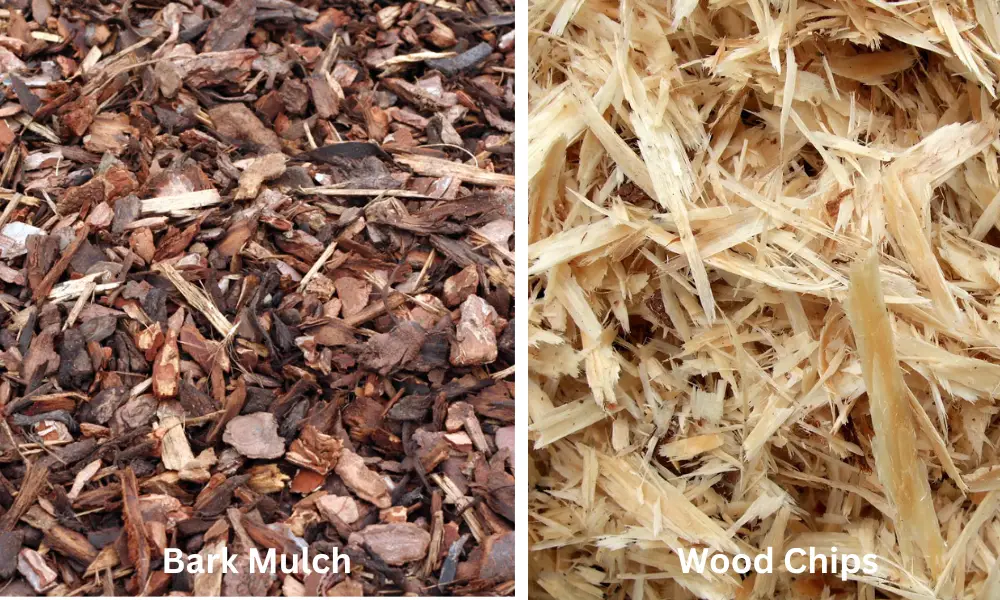
Wood Chip Mulch Pros And Cons
Wood chip mulch is a versatile and effective choice for enhancing your garden’s health and aesthetics. Derived from various wood types, these chips provide a natural and appealing appearance while offering multiple benefits.
They create a protective layer that suppresses weed growth, conserves soil moisture, and promotes aeration for healthier plant roots. With a longer lifespan compared to some other mulches, wood chips require less frequent replacement.
Their versatility allows for customization based on wood type and size, ensuring they align seamlessly with your landscaping goals. Ultimately, wood chip mulch stands out as a sustainable and visually pleasing solution for garden enhancement.
Pros:
- Moisture retention: Wood chip mulch is effective at retaining moisture in the soil, which can be beneficial for plants that require consistent watering. It helps to prevent evaporation and can reduce the frequency of watering required.
- Weed suppression: Wood chip mulch can help to suppress weeds by blocking light and preventing weed seeds from germinating. This can save gardeners time and effort spent on weeding.
- Soil temperature regulation: Wood chip mulch can help to regulate soil temperature by insulating the soil and preventing extreme temperature fluctuations. This can be beneficial for plants that are sensitive to temperature changes.
- Aesthetically pleasing: Wood chip mulch can add a natural look to a garden or landscape and can complement a wide range of plant species. It is available in a variety of colors and can be used to create a cohesive look in a garden or landscape.
Cons:
- Initial cost: While wood chip mulch is generally inexpensive, the initial cost of purchasing and applying it can be relatively high, especially if you have a large area to cover.
- Decay: Wood chip mulch will eventually decompose and will need to be replaced. This can be a time-consuming and costly process, depending on the size of the area being mulched.
- Insects: Wood chip mulch can attract insects, including termites and carpenter ants, which can be a problem if they infest the wood chips or your home.
- Chemical residues: Wood chip mulch can potentially contain chemical residues from the wood it was made from, such as pesticides or herbicides. This can be a concern for those who want to use organic mulch or for those who are sensitive to chemicals.
Tan Bark vs. Wood Chips
Tan Bark vs. Wood Chips: Choosing the Right Mulch for Your Garden, When it comes to enhancing your garden’s aesthetics and promoting plant health, the choice between tan bark and wood chips for mulching is a pivotal decision. Let’s delve into the distinctions to help you make an informed choice for your landscaping needs.
Tan Bark:
Pros:
- Aesthetic Appeal: Tan bark, derived from shredded tree bark, adds a natural and earthy look to garden beds, enhancing overall visual appeal.
- Moisture Retention: It excels at retaining moisture, creating a favorable environment for plant roots and reducing the frequency of watering.
- Insulation Properties: Tan bark provides insulation to the soil, helping regulate temperature and protect plant roots from extreme weather conditions.
- Gradual Decomposition: Tan bark decomposes slowly, contributing organic matter to the soil over time and enriching its fertility.
Cons:
- Nutrient Depletion: As tan bark decomposes, it may temporarily deplete nitrogen from the soil, impacting the early stages of plant growth.
- Floating Concerns: In heavy rainfall, tan bark may float or wash away, necessitating occasional replenishment.
Wood Chips:
Pros:
- Versatility: Wood chips come in various sizes and types of wood, offering versatility in appearance and functionality.
- Longevity: They have a longer lifespan compared to some other mulches, reducing the frequency of reapplication.
- Weed Suppression: Wood chips create a dense layer, effectively suppressing weed growth and minimizing competition for resources.
- Soil Aeration: Wood chips allow for good air circulation, promoting a healthy soil structure.
Cons:
- Aesthetic Variation: The appearance of wood chips can vary based on the type of wood used, potentially affecting the overall look of the garden.
- Decomposition Time: While they decompose more slowly than some mulches, wood chips will eventually break down and require replacement.
| Tan Bark | Wood Chips |
|---|---|
| Effective at suppressing weeds | Not as effective at suppressing weeds |
| Adds a decorative touch to gardens | Less visually appealing |
| Retains moisture well | Larger and less uniform |
| May deplete soil of nitrogen | May deplete the soil of nitrogen |
| Ideal for use in landscaping | Ideal for use in vegetable gardens |
| Consider soil type and type of plants when choosing | Consider soil type, desired longevity, and availability when choosing |
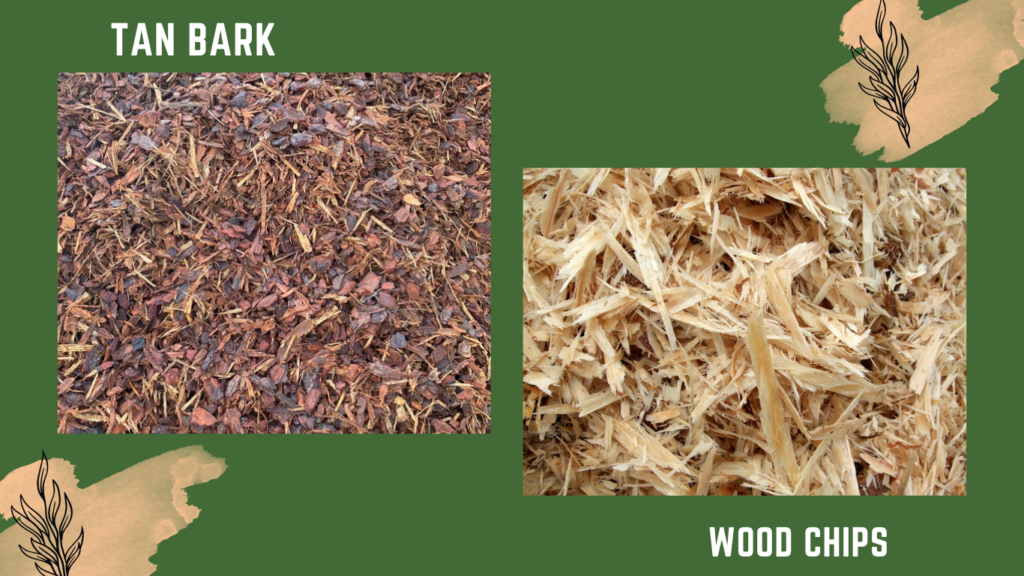
Pine Bark Vs Wood Chips Pros And Cons
Pine bark mulch is a popular landscaping material that comes with both pros and cons. This mulch is made from the bark of pine trees and is a great alternative to traditional mulch options. In this report, we will examine the pros and cons of using pine bark mulch in your garden and landscaping projects.
Pros:
- Aesthetically pleasing: Pine bark mulch is a beautiful addition to any garden or landscaping project. It has a natural brown color that complements a variety of plants and flowers. Plus, its chunky texture adds depth and dimension to your garden.
- Good drainage: Pine bark mulch has excellent drainage properties. It allows water to percolate through the soil, which helps to prevent root rot and other plant diseases. In addition, it also helps to regulate the soil temperature.
- Long-lasting: Pine bark mulch breaks down slowly, which means it can last for years without needing to be replaced. This is great for homeowners who want a low-maintenance option.
- Eco-friendly: Pine bark mulch is a natural product that is sourced from sustainable forest practices. This means that it is an eco-friendly option that is good for the environment.
Cons:
- Expensive: Compared to traditional mulch options, pine bark mulch can be quite expensive. It is important to keep this in mind when budgeting for your landscaping project.
- Attracts pests: Pine bark mulch can attract termites and other pests. This can be a problem for homeowners who want to avoid pests in their garden.
- Acidic: Pine bark mulch is acidic, which can be a problem for some plants. It is important to test the pH of your soil before using pine bark mulch to ensure that it is not too acidic.
- Not suitable for windy areas: Pine bark mulch is lightweight and can blow away in windy areas. This can be a problem for homeowners who live in areas with high winds.
What Lasts Longer Bark Or Wood Chips?
Bark and wood chips are made from trees, so it stands to reason that they would break down at about the same rate, right? Well, not necessarily. It turns out that bark lasts significantly longer than wood chips when used as mulch.
Here’s why:
Bark is more resistant to decomposition than wood chips because it has a higher lignin content. Lignin is a natural polymer that gives plants their rigidity and strength. It’s also what makes bark darker in color than wood chips.
This extra lignin makes bark slower to break down and therefore last longer as mulch. So, if you’re looking for mulch that will last longer and give your garden beds a neat, finished look, go with bark.
Are Bark Chips Better Than Mulch?
When it comes to landscaping, there are a variety of different options available for ground cover. Two of the most popular choices are bark chips and mulch. But which one is better?
Bark chips are made from tree bark that has been shredded or chipped into small pieces. They offer several benefits, including:
- Weed suppression: Bark chips can help prevent weeds from growing in your garden beds by creating a barrier between the soil and the sunlight.
- Moisture retention: Bark chips help to keep the soil moist by trapping water and preventing evaporation. This is especially beneficial during hot, dry summer months.
- Aesthetics: Bark chips can give your garden beds a tidy, finished look.
They come in various colors (including red, brown, and black), so you can find an option that compliments your landscape design. Mulch is another popular choice for ground cover. It’s made from organic materials (such as leaves, grass clippings, or wood chips) that have been composted into thick matting.
Mulch offers many of the same benefits as bark chips, including weed suppression and moisture retention. However, it also has a few unique advantages, such as:
- Nutrient enrichment: As the mulch decomposes, it releases nutrients into the soil, benefiting plants’ roots.
Is Bark Mulch the Same As Wood Chips?
Bark mulch and wood chips are two very different things. Bark mulch is made from the bark of trees and shrubs and covers the ground around plants. It helps to retain moisture in the soil, prevent erosion, and keep weeds down.
Wood chips, on the other hand, are made from whole trees that have been chipped into small pieces. They can be used for various purposes, including landscaping, playgrounds, and garden paths.
What is the Difference between Mulch And Woodchips?
Mulch and woodchips are both products that can be used in landscaping to improve the appearance of your yard and help protect your plants. Both mulch and woodchips are made from organic materials, but there are some key differences between the two. Mulch is usually finer than woodchips, making it more appropriate for use around delicate plants.
Mulch also breaks down more quickly than woodchips, providing nutrients to the soil as it does so. Woodchips, on the other hand, last longer and can be a good choice for areas where you need ground cover or erosion control.
Which is better for your yard – wood chips or mulch?
Cost of Wood Chips
Wood chips are a type of biomass, which is organic matter that can be used to produce energy. Biomass can be used to generate electricity or heat, and wood chips are one of the most common types of biomass fuel.
Wood chips have a high energy density and they burn relatively cleanly.
However, they do release some pollutants into the atmosphere, including carbon dioxide and particulate matter.
The cost of wood chips varies depending on the source and quality of the material. For example, sawdust from lumber mills is often used as fuel for boilers or kilns, and it typically costs less than wood chips that are specifically grown for fuel purposes.
Arborist Wood Chips Vs. Mulch
Arborist wood chips and mulch are two popular options for landscaping. Both have their pros and cons, so it’s important to choose the right one for your needs. Arborist wood chips are a great option for covering large areas quickly.
They’re also relatively cheap and easy to find. However, they can be messy and difficult to spread evenly. They also don’t last as long as mulch, so you’ll need to replenish them more often.
Mulch is another popular option for landscaping. It’s made from organic materials like bark or leaves, and it’s available in a variety of colors. Mulch is easier to spread than wood chips, and it lasts longer too.
However, it can be more expensive than wood chips, and it doesn’t always look as good initially.
Frequently Asked Questions
Which is better wood chips or mulch?
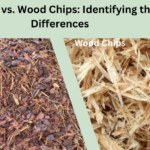
Choosing between wood chips and mulch depends on your specific gardening needs. Wood chips provide a durable option for pathways and play areas, offering good longevity. Mulch, typically made from organic materials, enhances soil fertility, retains moisture, and suppresses weeds. Consider factors such as aesthetic preference, plant types, and maintenance requirements to determine which suits your landscaping goals best.
What is the difference between wood and bark mulch?
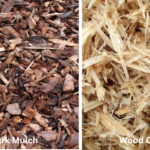
Wood mulch is a broad term encompassing various materials derived from wood. Bark mulch specifically refers to the outer protective layer of a tree trunk. While wood mulch may include chipped or shredded branches, bark mulch consists primarily of tree bark. Bark mulch tends to decompose more slowly, offering longer-lasting weed suppression and insulation for plant roots, but both types of mulch contribute to soil health and moisture retention in landscaping.
What are the disadvantages of wood chips?
Wood chips have some disadvantages, including potential nitrogen depletion as they decompose, which may affect plant growth. They can also attract termites and other pests, posing a risk to nearby structures. Additionally, certain wood types may release allelopathic chemicals that inhibit plant growth.
What are the disadvantages of mulching?
Disadvantages of mulching include the risk of overmulching, which can lead to root rot and hinder air and water exchange. Some mulches may attract pests, and improper application can contribute to mold or fungus growth. Additionally, certain mulches may contain weed seeds, introducing unwanted plants to the garden.
Conclusion
Bark mulch is made from the bark of trees and shrubs, while wood chips are made from tree branches, twigs, and leaves. Bark mulch is darker in color and has a finer texture than wood chips. It also breaks down more slowly, making it ideal for long-term use in gardens. Bark mulch is also more expensive than wood chips.
Related Articles
10 Best Small Evergreen Trees with Non Invasive Roots
 Dr Ahsanur Rahman, PHD
Dr Ahsanur Rahman, PHDPine Tree Rescue: Saving Pine Trees with Brown Needles
 Dr Ahsanur Rahman, PHD
Dr Ahsanur Rahman, PHD




